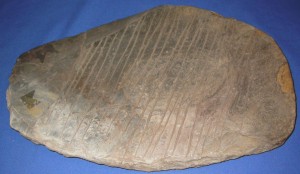Greetings from the Museum of Tropical Queensland (MTQ). My name is Letitia Murgha and I am a member of the Strategic Learning team which is comprised of four seconded teachers from Education Queensland. We do lots of things across the museum network as you will have read in previous blogs. As an indigenous elder and experienced teacher, my main role is to work alongside Trish Barnard (Senior Curator for Cultures & Histories Customs, Cultures and Country) at MTQ to develop new learning resources from an indigenous knowledge perspective. These resources are aligned with the new Australian Curriculum. I’d like to tell you about an aboriginal object from the state collections that I have been investigating that will be included in a set of new Aboriginal Science kits. The special object is called a Morah stone.

To the casual observer it may seem to be a stone with scratches all over it but to the Aboriginal people of the North Queensland rainforest this stone aided their ability to survive, sustain themselves and to prosper. It is known as a Morah stone and is a specialised type of grooved grindstone formed from sedimentary rock, such as grey slate. It was an integral tool used by Aboriginal people, especially the women, of the rainforest who used it to process particular plant types such as the Zamia Palm (Lepidozamia hopei) and Black Bean (Castanospermum australe). These distinct plant types while abundant in the rainforest are highly toxic. The rainforest people knew about the toxicity of these plants and through scientific processes discovered how to extract the toxin from them. The stone was invented as an aid in extracting toxins from the seeds of the toxic plants. The rainforest might look and feel cool and inviting, but there lurks many hidden dangers.
Of the many rock types slate was chosen because it formed into smooth flat sheets. Slate has a low water absorption index. It is also fireproof and has a level of resistance to breakage and is easily portable. It is a very handy tool. Most morahs have roughly parallel incised grooves running across the grinding surface perpendicular to the axis of the stone. These grooves or incisions would most likely have been made with a pointed bone, sharp stone or piece of sharp coral.
You may wonder how aboriginal people used the Morah stone. The seeds/kernels were placed on the incised Morah stone and the moogi, usually a harder stone, placed on top and in a rolling pushing and pulling motion grated the seeds/kernels. This motion allowed for a quantity of meal, mashed seed kernels, to be crushed in a short time as the next step in the process was to leach this meal inside a basket in running water. Using this motion across the stone the incised grooves facilitated the breakup of the starchy kernels.
How do we know which seeds were ground and leached? Results of scientific analysis on residue analysis from the Morah stones suggest that Aboriginal groups settled on a more permanent basis in the rainforest. The residue analysis from some Morah stones found in North Queensland revealed the specific types of seeds which were ground down. Food sources such as the Zamia seeds provided a high carbohydrate, protein and energy diet as well as being low in fat. Six species of toxic plant sources in the rainforest provided and formed part of the Aboriginal people’s staple food source thatup
The Morah stone is no ordinary stone.
The Morah stone along with other tools invented by Aboriginal people will feature in the new loans kits developed by Queensland Museum. Multiple Learning Kits will be available for loan by metropolitan and regional borrowers. The resources will be of particular interest for local area studies in schools, embedding Aboriginal and Torres Strait Islander perspectives into the curriculum and most importantly being aligned with the new Australian Curriculum: Science.


You must be logged in to post a comment.